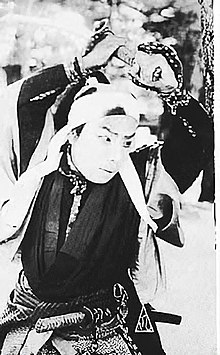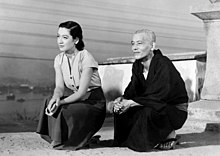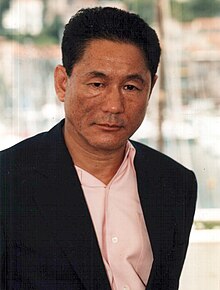Japan cinema
Japan's cinema (日本映画; Nihon-Eiga) has a history spanning more than 100 years. The import from France of a Lumière brothers' cinematograph in 1897 marked the dawn of cinema in Japan.
Japan has one of the oldest and largest film industries in the world; in 2010, it was the fourth largest producer of feature films worldwide. Japan has won the Academy Award for Best Foreign Language Film five times, more than any other Asian country.
Genres
- Anime, with this term is known to Japanese animation.
- Jidaigeki, epoch dramas usually set in the Edo Period (1603-1868). Within this genre, is the chambara (action cinema with samurai).
- J-Horror Or horror cinema. It predominates psychological terror and tension, with the intervention of ghosts and poltergeists.
- cult cinema. Understand those movies that attract a small group of followers, like Battle Royale or Suicide Club.
- Kaiju: Movies whose protagonist is a monster, like the popular Godzilla.
- Pink films or pornographic cinema. Unlike western pornographic cinema, Japanese porn cinema usually includes social themes and is aesthetically more careful.
- Yakuza. Movies that deal with the Japanese mafia.
History
From its beginnings to the 1940s
The first movie camera imported into Japan was made by Gaumont. Geishas from Tokyo were filmed several times with this camera, considered the first entertainment film shot in the country. However, the kabuki piece Momijigari, with a purely theatrical content, is considered the first film production. Japanese film being shot in 1899 by Tsunekichi Shibata, a photography engineer.
The first star of Japanese cinema was Matsunosuke Onoe, a kabuki actor who appeared in more than 1,000 films, mostly short films, between 1909 and 1926. He and director Shozo Makino made films in the genre popular jidaigeki. As for Japanese actresses, the first to appear professionally in film was Tokuko Nagai Takagi, who appeared in four short films for the American production company Thanhouser Company between 1911 and 1914.
During the silent film period, most movie theaters employed benshis, narrators whose dramatic readings accompanied the film and its soundtrack, which, as in the West, was usually performed live. Within this genre, some of the most commented films are those of the director Kenji Mizoguchi.
Catastrophes such as the Great Kanto earthquake of 1923, the bombing raids on Tokyo during World War II, together with the natural effects of time and humidity on the then most fragile celluloid, have contributed to the fact that very few surviving films of this period.
A survey of the gendaigeki genre - dealing with modern or contemporary dramas - and film scriptwriting in the 1910s-1920s, can be found in Writing in Light: The Silent Scenario and the Japanese Pure Film Movement (Joanne Bernardi, Wayne State University Press, 2001). The work includes some translations of complete scripts.
Unlike Hollywood film production, silent films were still being produced in Japan during the 1930s. Of note in this period are the sound films by Kenji Mizoguchi The Sisters of Gion (Gion no shimai) from 1936, Elegy of Naniwa ( Naniwa erejî) from the same year and The Story of the Last Chrysanthemum (Zangiku monogatari) from 1939. These, together with the films by Sadao Yamanaka, 1937's Ninjo Kamifusen and Mikio Naruse's Tsuma Yo Bara No Yoni from 1935 were the first Japanese films to be released in the United States. However, censorship pressure was felt among directors with leftist political leanings like Daisuke Ito.
Akira Kurosawa released his first feature film The Legend of the Great Judo (Sanshiro Sugata) in 1943. At the end of World War II, and during the occupation under Douglas MacArthur, Supreme Commander of the Allied Forces, Japan was exposed to more than a decade of American animated cinema, banned by the Japanese government during the war.
The successful film Late Spring (Banshun) directed by Yasujirō Ozu in 1949 also stands out.
1950s, the “Golden Age”
The 1950s saw the "Golden Age" of Japanese cinema. The decade begins with Akira Kurosawa's Rashōmon (1950), which won the honorary Oscar for Best Foreign Film marking the entry of Japanese cinema into the rest of the world. It was also the role that catapulted the career of the legendary Toshirō Mifune. In 1952 Kurosawa premiered Ikiru, and in 1953 Yasujirō Ozu completed his masterpiece Tales from Tokyo.
The year 1954 produced two of the most influential feature films in Japanese cinema. The first was Akira Kurosawa's epic The Seven Samurai, about a group of samurai who are hired to protect a village from a gang of rapacious thieves. The Seven Samurai has had various adaptations, among which the film The Magnificent Seven, a 1960 John Sturges western, stands out.
That same year, Ishirō Honda released the anti-nuclear horror film Gojira, known in the West as Godzilla. Though severely edited for its Western release, Godzilla became an international icon of Japan and kick-started the Kaiju genre film industry.
In 1955, Hiroshi Inagaki won an Oscar for Best Foreign Film for the first part of his trilogy on the life of Miyamoto Musashi, Samurai I.
Kon Ichikawa directed two anti-war dramas: The Burmese Harp (1956), and Fire on the Plain (1959), along with Conflagration (1958), an adaptation of the novel The Golden Pavilion by Yukio Mishima.
Masaki Kobayashi made three feature films, collectively known as the Human Condition Trilogy, between 1958 and 1961.
Kenji Mizoguchi directed Life of O-Haru, a Gallant Woman (Saikaku Ichidai Onna) (1952), Tales of the Pale Moon (Ugetsu Monogatari) (1953), which won the Silver Lion at the Venice Film Festival, and The Intendant Sansho (Sansho Dayu) (1954).
Mikio Naruse did Meshi (1950), Bangiku (1954), The Voice of the Mountain (Yama no oto) (1954) and Floating Clouds (Ukigumo) (1955).
Yasujirō Ozu directed Good Morning, (Ohayō) (1959) and Ukikusa (1958), which was an adaptation of his previous film silent Ukigusa monogatari (1934), featuring Kazuo Miyakawa, cinematographer of Rashomon and Intendant Sansho
Between 1960 and 1990
The new Japanese wave (noveru vagu) was a movement that emerged at the end of the 1950s and characterized by the awareness of Japan in the postwar period, where the main representatives of the movement spent their first years. Some directors established themselves as the main filmmakers of the new wave: Shōhei Imamura with Nippon konchuki (1963), and Nagisa Ōshima with Cruel Tales of Youth (1960). Hiroshi Teshigahara's film The Woman in the Sand, based on the novel by Kōbō Abe, won the Jury Prize at the Cannes Film Festival in 1964, and was nominated for an Oscar for Best Director and an Oscar for the best foreign language film. Masaki Kobayashi's film Kwaidan also won the Cannes Jury Prize the following year.
Within the same wave, Ōshima directed The Empire of the Senses (1976), a controversial film about the true story of Abe Sada. Strongly opposed to censorship, the director insisted that the film contain explicit pornographic material and, as a consequence of that decision, the film could not be shown in Japan, where, to date, it has not yet been shown except censored, and had to appear in France.
Outside the new wave, in the 1960s, directors already recognized as such continued their work. Thus, Akira Kurosawa directed the classic Yojimbo in 1961, whose impact on the western film genre was considerable. Also, Kon Ichikawa captured the essence of the 1964 Tokyo Olympics in his three-hour documentary The Tokyo Olympics (Tōkyō Orimpikku) (1965).
Yoji Yamada created and directed the commercially successful series Otoko wa tsurai yo (It's tough being a man), with actor Kiyoshi Atsumi as Tora-san, of which 48 films were made (1969–1995). Meanwhile, he was directing other films among which the popular Shiawase no kiiroi hankachi (1977) (The Yellow Handkerchief of Happiness) stands out.
Also in the 1970s, Kinji Fukasaku completed Battles Without Honor and Humanity (1973), the first of the five-film saga titled The Yakuza Papers. Shôgorô Nishimura himself directed Dan Oniroku: Nawa-Geshô (1978), one of the most famous erotic films of the Nikkatsu production company, with Naomi Tani in the main role.
In the following decade, Akira Kurosawa directed Kagemusha, which won the 1980 Palme d'Or at the Cannes International Film Festival. The same year, Seijun Suzuki returned to the film medium with his film Zigeunerweisen receiving four Japanese Academy Awards. For his part, Shohei Imamura won the Palme d'Or at the Cannes International Film Festival in 1983 for his film The Ballad of Narayama (1983).
In 1985 Kurosawa made his work Ran. With a budget of US$12 million, she was the winner of an Oscar for Best Costume Design.
The Anime
Animation in Japan is called anime, although much of its development is based on television series, in its history it has had great exponents who have dedicated themselves to animated cinema.
The so-called father of anime Osamu Tezuka together with director Eiichi Yamamoto worked on the trilogy called Animerama, three films considered precursors of adult animation: Senya Ichiya Monogatari (also known as The Thousand and One Nights)(1969), Kureopatora (also known as Cleopatra) (1970) and Kanashimi no Belladonna (also known as The Sadness of Belladonna) (1973). Despised in their time, over time they have come to be considered cult.
Hayao Miyazaki made in 1984 the anime film Nausicaä of the Valley of the Wind, adapted from the manga series of the same name, created by him. He then made two national and international blockbusters Porco Rosso (1992) and Princess Mononoke (1997). In 2001, he directed Spirited Away, the animation that became the highest-grossing film in the history of Japanese cinema and winner of the Oscar for Best Animated Film (2002) and the Oso de Gold from the Berlin International Film Festival (shared) among others.
Another skilled director, Miyazaki's partner at Studio Ghibli, was Isao Takahata (1935-2018), best known for his 1988 adaptation of the Akiyuki Nosaka novel, Grave of Fireflies, which tells the story of two children who try to survive after losing their mother during a bombing raid on the city of Kobe in World War II, he also directed other films such as Memories of Yesterday (1991) and The Tale of Princess Kaguya (2013).
In 1988 Katsuhiro Otomo adapted his manga series Akira into the anime of the same name.
Other anime directors appeared, bringing new concepts, not only as movies, but also as examples of modern art. Like Mamoru Oshii with his science fiction film Ghost in the Shell (1995) (Kôkaku kidôtai), based on the manga by Masamune Shirow, of great international success and to which the director would make a sequel, Ghost in the Shell 2: Innocence (2004).
Hideaki Anno achieved notable recognition after the presentation of his successful and controversial 26-episode series, Neon Genesis Evangelion (1995), a series that ended with the film The End of Evangelion (1997), franchise taken up ten years later, when he made a restart of said story in a cinematographic tetralogy known as Rebuild of Evangelion (2007-2021), a director who has also worked on real-image films such as Shin Godzilla (2016).
Anime director Satoshi Kon (1963-2010) made the successful films Perfect Blue (1997), Millennium Actress (2001), Tokyo Godfathers (2003) and Paprika (2006), his films have been a source of inspiration for Hollywood directors such as Darren Aronofsky and Christopher Nolan.
Another notable director is Rintaro, who initially worked with Osamu Tezuka on television series such as Astro Boy and in 2001 directed the film Metropolis, which adapted Tezuka's manga of the same name, which in turn was inspired by the 1927 film of the same name directed by Fritz Lang.
The first two decades of the 21st century saw the rise of other directors who have taken over from the previous generation, such as Mamoru Hosoda, Makoto Shinkai, Keiichi Hara, Naoko Yamada, Mari Okada, Hiromasa Yonebayashi, Gorō Miyazaki, Sunao Katabuchi, Masaaki Yuasa, Hiroyuki Imaishi and Japan-based American director Michael Arias, among others. Highlighting films such as Tekkonkinkreet (2006), Colorful (2010), Poppy Hill (2011), Wolf Children (2012), The Memory of Marnie (2014), A silence voice (2016), Your name (2016), In this corner of the world (2016), The night is short, walk on girl (2017), Maquia, an immortal love story (2018), Promare (2019).
In anime cinema there are many films associated with television franchises such as Dragon Ball, Doraemon, One Piece, Pokémon, Naruto, Lupine III, My Hero Academia, among others, some of them are summaries of the television seasons, others are Derivative stories and there are also those that are a continuation of the story broadcast on television. These types of films have been great box office successes, such as Kimetsu no Yaiba: Mugen Ressha-hen (2020), belonging to the Kimetsu no Yaiba franchise.
Since 1990
After making low-budget films, Kiyoshi Kurosawa oriented his creations to other genres that were being appreciated internationally such as Cure (1997).
Shohei Imamura won again the Palme d'Or award at the Cannes International Film Festival (shared), for his film The Eel (1997).
Takeshi Kitano establishes himself as an important filmmaker, with works such as Sonatine (1993), Kizzu ritân (1996) and Fire Flowers (1997), the latter Winner Golden Lion Award at the Venice Film Festival
Takashi Miike began his prolific career, making more than 50 films in a decade, including Chûgoku no chôjin (The Bird People in China) (1998), Audition (1999) and Dead or Alive: Hanzaisha (1999).
Satoshi Kon directed Perfect Blue (1997), a psychological thriller, awarded at the Porto International Film Festival and the Fant-Asia Film Festival of Canada. Subsequently, the director Toshiki Sato would make the feature film Perfect Blue: Yume nara samete (2002). Both films are based on Yoshikazu Takeuchi's novel of the same name.
Kinji Fukasaku's film Battle Royale (2000) caused controversy and was banned or censored in several countries, but it achieved box office success in Japan and also gained cult status in the UK.
Takeshi Kitano made Dolls (2002), the director who used to appear as an actor in his films, doesn't do so this time, and Zatōichi (2003) both written by he.
Some Japanese horror films: Ringu (1998), Kairo (2001), Dark Water (2002), Yogen (2004); and Takashi Shimizu's Ju-on series were made in this decade as an adaptation, reaching box office success.
The film Godzilla: Final Wars (2004) is directed by Ryuhei Kitamura, commemorating the 50th anniversary of the mythical fictional character.
Veteran director Seijun Suzuki directs his 56th film Operetta tanuki goten (2005) (Princess Raccoon).
Hirokazu Koreeda directed Distance (2001) and Nobody Knows (2005), the latter winning numerous awards.
Multi-faceted director Sion Sono shot Suicide Club (2002), Strange Circus (2005), Hazard (2005), Noriko's Dinner Table (2005) and Exte:Hair extensions (2007).
Film festivals and awards in Japan
- Kinema Junpo Awards since 1925.
- Mainichi Film Concours since 1947.
- Blue Ribbon Shou since 1951 = Blue Ribbon Awards
- Hochi Eiga Shou since 1976 = Hochi Film Award
- Japanese Academy Awards Nippon Academii-Sho since 1977.
- Yokohama Film Festival since 1980
- Tokyo International Film Festival (TIFF) since 1985
- The International Animation Festival Hiroshima since 1985
- Yamagata International Documentary Film Festival since 1989
- Tokyo Anime Awards since 2002
- Tokyo International Lesbian & Gay Film Festival (Tokio) since 1992
- Tokyo Filmex since 2000
- The Kansai International Film Festival (Osaka) since 2007
Contenido relacionado
Renee Zellweger
Open your eyes (film)
Islamic art






